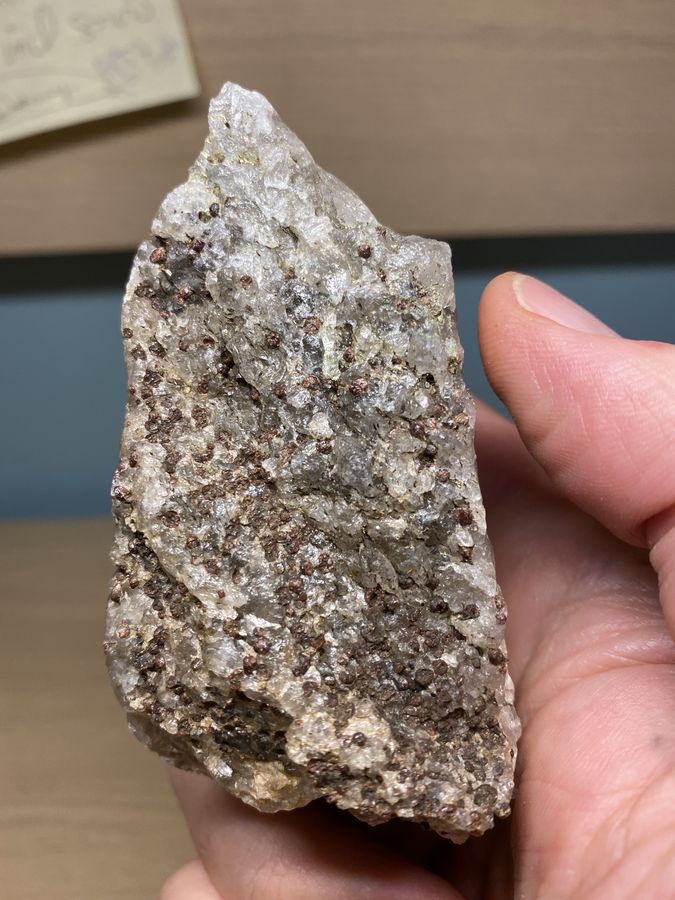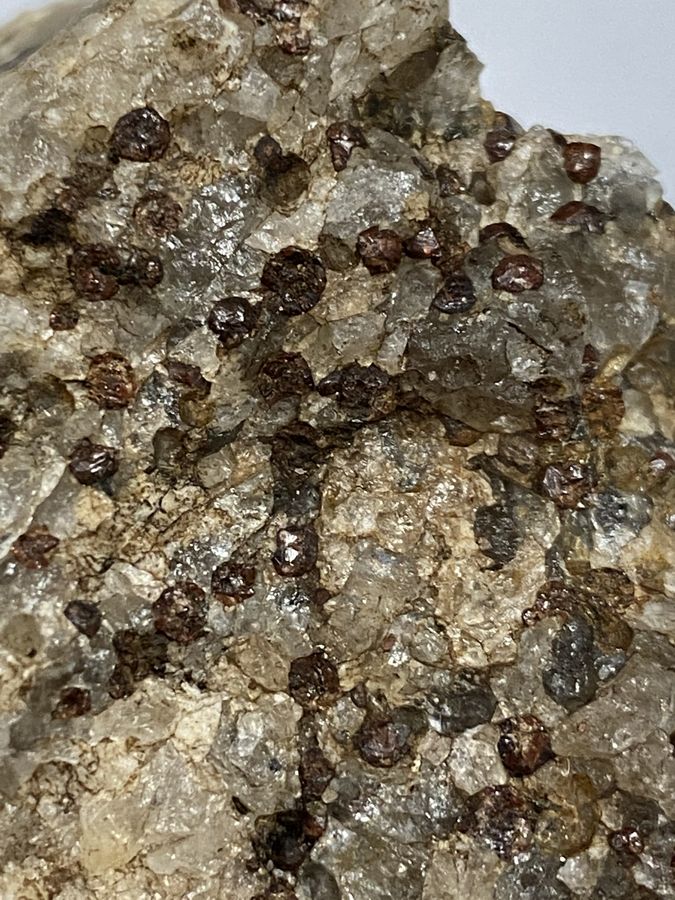| View previous topic :: View next topic |
| Author |
Message |
JPONext
Joined: 25 Oct 2020
Posts: 3
Location: northern ontario


|
 Posted: Oct 27, 2020 19:03 Post subject: Quartz with small garnets Posted: Oct 27, 2020 19:03 Post subject: Quartz with small garnets |
|
|
Hello:
Need some help to determine what the garnets are, and what they might mean to the geology of that area. Are they an indicator to anything else that might be around?
There is biotite in the area, granite and some mica as well. The garnets are 1-2mm, soft as they break with a knife blade, brown-red in colour
Thank you kindly!
| Mineral: | Quartz |
| Locality: | | Timmins area, Cochrane District, Ontario, Canada |  |
|
| Dimensions: | 9cm |
| Description: |
|
| Viewed: |
6269 Time(s) |

|
|
|
| Back to top |
|
 |
Bob Carnein
Joined: 22 Aug 2013
Posts: 354
Location: Florissant, CO



|
 Posted: Oct 27, 2020 20:11 Post subject: Re: Quartz with small garnets Posted: Oct 27, 2020 20:11 Post subject: Re: Quartz with small garnets |
|
|
| Garnet varieties can't be positively identified by sight. That said, the "normal" garnet in metamorphic rocks such as gneiss or mica schist is almandine. Almandine indicates medium grade regional metamorphism but doesn't really suggest much about other minerals likely to be present. Almandine is actually pretty hard---to test hardness, try rubbing the garnet on a knife blade or a piece of glass (it should leave a scratch). Brittle or fractured mineral grains may break when rubbed with a knife point, but that isn't really a measure of hardness.
|
|
| Back to top |
|
 |
JPONext
Joined: 25 Oct 2020
Posts: 3
Location: northern ontario


|
 Posted: Oct 27, 2020 21:26 Post subject: Re: Quartz with small garnets Posted: Oct 27, 2020 21:26 Post subject: Re: Quartz with small garnets |
|
|
| Bob Carnein wrote: | | Garnet varieties can't be positively identified by sight. That said, the "normal" garnet in metamorphic rocks such as gneiss or mica schist is almandine. Almandine indicates medium grade regional metamorphism but doesn't really suggest much about other minerals likely to be present. Almandine is actually pretty hard---to test hardness, try rubbing the garnet on a knife blade or a piece of glass (it should leave a scratch). Brittle or fractured mineral grains may break when rubbed with a knife point, but that isn't really a measure of hardness. |
Ok, I will try with a knife again. Also, I am about to assay several rock samples, is there any value to assaying this one as well?
| Locality: | | Timmins area, Cochrane District, Ontario, Canada |  |
|
| Dimensions: | 9cm |
| Description: |
|
| Viewed: |
6250 Time(s) |

|
|
|
| Back to top |
|
 |
Bob Carnein
Joined: 22 Aug 2013
Posts: 354
Location: Florissant, CO



|
 Posted: Oct 28, 2020 09:19 Post subject: Re: Quartz with small garnets Posted: Oct 28, 2020 09:19 Post subject: Re: Quartz with small garnets |
|
|
| The close-up appears to be a garnet-mica schist. Personally, I doubt that there would be any value in assaying it. Such rocks cover huge areas in many mountain belts and don't normally contain anything of economic value.
|
|
| Back to top |
|
 |
JPONext
Joined: 25 Oct 2020
Posts: 3
Location: northern ontario


|
 Posted: Oct 30, 2020 16:31 Post subject: Re: Quartz with small garnets Posted: Oct 30, 2020 16:31 Post subject: Re: Quartz with small garnets |
|
|
| Bob Carnein wrote: | | Garnet varieties can't be positively identified by sight. That said, the "normal" garnet in metamorphic rocks such as gneiss or mica schist is almandine. Almandine indicates medium grade regional metamorphism but doesn't really suggest much about other minerals likely to be present. Almandine is actually pretty hard---to test hardness, try rubbing the garnet on a knife blade or a piece of glass (it should leave a scratch). Brittle or fractured mineral grains may break when rubbed with a knife point, but that isn't really a measure of hardness. |
Hello Bob - I tried the hardness test and they are more durable than I first thought. A knife blade will cut through the garnet and shatter somewhat like glass but an ice pick won't break them easily, if that makes any sense. Almandine might be right? They are only about 2mm in diameter. Also, I was able to find a couple of garnets on the rock's edge to scratch a round glass jar and yes, they left scratches, they are harder than glass.
I also found what appears to be visible gold in the quartz on both rock samples, quite small, but will get a sample assayed.
Anything else you can tell me about them?
|
|
| Back to top |
|
 |
|





